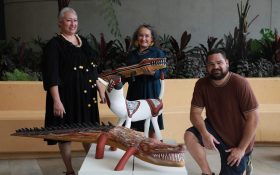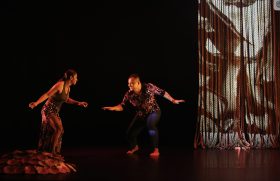It’s clear from the response to Richard Watts’ recent piece about changes at Barking Gecko that governance is far from a tired topic in the arts.
Governance is the site of compliance and strategy; risk, leadership, and followership. Social media comments on Watts’ piece indicated persistent fear, ignorance, and the unhealed wounds of arts workers and Board members regarding such topics. For me they also re-opened a vein, and I found myself obsessing about systemic issues for several hours on a lockdown August Saturday.
Upfront: I have no knowledge or connection with Barking Gecko and nothing here is intended as a comment on that situation. On the other hand, I do have experience as a staff member, contractor, volunteer, Board member, CEO, job interviewee and Chair in commercial and not-for-profit arts organisations.
I’ve experienced some bad behaviour on both sides. Being screamed at and fired because a composer hated orchestrations, and a mid-interview delivery and consumption of a fancy catered lunch – not offered to me – in the Melbourne high-rise office of an entrepreneur Board member readily come to mind. So, I wanted to share some of what I pondered and also address some of the perspectives on Boards that really surprised me.
Read: Nightmare chairs and how to survive them
‘What we do’ i.e. art is our critical asset: the capital we seek to preserve and grow or extend. To many of us, the dividend is two-fold: the intangible or ephemeral intake of breath at witnessing something incredible; and the potential for revenue that we can plough into our next endeavour.
Artmaking is reflected in the lofty visions and missions contained in foundational documents and on most of our websites – but our attitude to money and who will provide it is usually veiled in words like ‘sustainable’ and ‘viable’ whose precise meanings are unclear. This, and obfuscation and opacity about individual and organisational ambition, is often reinforced by a false binary of Board members supporting decisions that prioritise growth of financial capital and reserves, while arts workers prioritise short-term resource needs for the full realisation of creative projects.
As the foundation of organisations, governance is the field in which the power relationships are performed and perceived. The roles of Board members are specifically created in company legislation and many companies also impose additional responsibilities.
Governance describes the need to monitor the theory vs practice of mission/vision/constitution of the organisation while protecting the interests of the organisation’s stakeholders. So, I was surprised at the expressions of powerlessness in connection with the unaccountability of Boards.
Board members must ensure that a company can pay its expenses: fees and wages, GST and superannuation and more besides. Furthermore, Boards are responsible for monitoring and nurturing a culture of compliance with laws ranging from equal opportunity to workplace safety.
No Directors and Officers (D&O) Liability Insurance will cover being ignorant of something happening in the organisation if a Board member has failed to ask reasonable questions or pushed to understand something they are told is ‘normal’. And I’m not the first to call this one: most of us working in the arts have experienced normalised work cultures of bullying, harassment, gender bias and/or racism. Far from being unaccountable, a Board is on the hook for all of the above – but may also reinforce unhealthy organisational cultures. Just as staff members might.
Read: Top 3 tips for emerging arts managers
It’s not unusual for the Board to feel they don’t understand the artmaking process and there is something unquantifiable about bring able to pick a ‘hit’ or having a good idea and then bringing it to fruition. But it does take some confidence and trust to advocate for a company with ephemeral assets, especially if your Board is ‘skills-based’ and you are being asked to contribute your skills. Plus, that’s your lens – that’s how you understand the world.
A message from staff that the Board member should shut up and tap their supposedly wealthy contacts for money is unproductive and insulting. It is of course equally annoying and offensive when inexpert critique or mere opinion is applied to creative process or to years-long producing, administrative and technical experience in a creative setting. Basically, no implication that someone is ‘the help’ in achieving your goal, untalented or incapable, is going to end well among a group that is supposedly dedicating itself to the same mission. This is where I think that we need to take risks more seriously.
Risk management is not only foreseeing a pandemic, a brick dropping on someone’s head or a key staff member leaving. It’s also about the risk of passing up on an opportunity. What if that performance is/isn’t made? What if we don’t relocate, merge, change mission? So, where my ponderings ended was on risk, and from experience identifying some important risks to think about:
For everyone:
Risk is not all one thing. We work in a ‘for purpose’ sector which is subject to almost every kind of economic shock, change in technology, culture war or battle outbreak, social change and weather event imaginable.
I think we’re well accustomed to living with ambiguity – those whose livelihoods rely on arts organisations and practices don’t have much control over their financial situations. So, I encourage you ‘do risk’: have difficult conversations, implement and recruit for organisational structures that meet the needs of the organisation, discuss shifts in power, changes, talk about money and the unpaid costs (volunteers including Board members, unpaid overtime etc) of preserving the art capital, so it’s clearer what your needs are for compliance and artmaking.
For those thinking of joining a Board:
Consider that finding the right Board to join might take a while. And be clear when looking: there’s work involved on top of meetings and all of it’s going to be voluntary, so please: no smell of burning martyr if a meeting is boring you or you don’t think information is well-presented.
Don’t forget that all Board members are on the hook for organisational culture as well as paying the bills, and also putting some effort into delivering the organisation’s art (its capital) through advocacy, fundraising, attending creative outcomes or more.
While advocacy, fundraising and attendance don’t appear in legal definitions of directors’ duties, there is an unambiguous duty to act in the company’s best interests and if that’s in the company’s best interests then that’s your job.
Artists on Boards and on staff:
You’re on the hook too. Plus, take communication and transparency risks on top of creative exploration. Take the risk of showing someone something before it’s finished – what the worst that can happen if you end up changing your mind and revise your planning? If your intention or process is opaque, you alienate Board members and colleagues and do not engender ongoing trust. Why would I dedicate long hours, advocate for your work, or tap friends for freebies or money if you don’t trust me enough to tell me what you’re doing or treat me like a necessary evil?
Chairs:
Get a mentor. Seek fearless feedback. Speak regularly with staff. I shamefully admit I have been disparaging about a staff member while a Chair, and I am forever grateful to another Board member for calling me out on it. I hope that if I am not doing a good job as Chair someone will take the risk of an awkward conversation and ask me to step down, but that’s what Board elections are for. You and or other Board members need to be available enough to understand how the company works and make calls on the nature of the way the company works. If a Board member is not performing their obligations, let them go.
Board members:
Just because someone doesn’t wear a suit, present well at Board meetings or talks about ‘playing’ in a rehearsal room, it doesn’t indicate a lack of skill. So, take the risk of trusting ‘different’ and asking the questions – and then by all means apply your reasonable judgement, but also be prepared to learn.
You know how to behave in your comfort zone but might need some help in a new environment. Apply your professional lens, knowing that no-one is in the room because they don’t care. As art is your capital, so are the freelance artists and artistic staff, and if they quit or go elsewhere your capital diminishes.
Oh and read your Board meeting papers – a lot of what you’re seeking is in there and if not, ask for it courteously and acknowledging existing resource priorities.
All staff:
You are not powerless – you represent the core capital of the company and know the most about how the organisation works.
Your Board is accountable for the wellbeing of the company by law, and also because of your organisation’s constitution or charter and the organisation’s policies. If you’re observing poor behaviour, call it out, through avenues your company is required to provide – including Board elections.
Make like a grown up and claim your due, but don’t forget you might be contributing to the issue. I mentioned fearless feedback, right?





